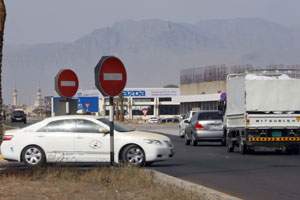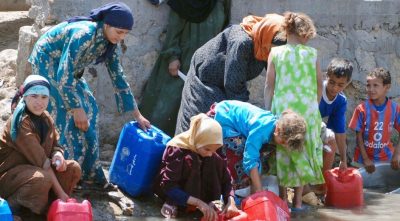E very day 35 people are killed in the Gulf as a result of poor driving. Mohd Shahnawaz has launched a new campaign to change the attitude behind the Gulf’s reckless drivers.
very day 35 people are killed in the Gulf as a result of poor driving. Mohd Shahnawaz has launched a new campaign to change the attitude behind the Gulf’s reckless drivers.
Just yesterday we posted a report that Iran has the highest rate of traffic fatalities, though that country competes with Saudi Arabia for the same dubious distinction. This was said to result in part from “cultural attitudes.” Those attitudes are being taken to task by Mohd Shahnawaz.
An engineer and entrepreneur by profession Mr. Shahnawaz started the Suraya Foundation in the United Arab Emirates after the death of his sister in an undisputed and possibly reckless driving incident.
Named after Mohd’s sister, Suraya is a road safety organization that aims to change attitudes of reckless drivers throughout the Middle East by spreading education about dangerous driving via the media. Here’s his story:Suraya
It all started when my sister named Suraya, an aspiring fashion designer, was on her way to her last day of university. She hurriedly left on the morning with her friend Aysha to the university. Two hours later, around noon we received a call from the hospital and rushed to find her extremely distressed. She was murmuring, “What happened to me?” and the doctor yelled, “Keep your hands down.” The nurses of the hospital seemed amateurish and the doctor had no clue how to deal with her trauma. Aysha had hip and leg damages.
Doctors mentioned my sister had internal bleeding and took her to ICU. Expert doctors were called and I saw them entering the room with an encyclopedia. Two hours later I saw a surgeon coming out and I asked him how she was doing. He asked if I was her brother then lackadaisically said she will not survive, and then walked away. An hour later she lost a lot of blood and what we feared the most happened: she passed away on March 17, 2009 at 3:54 p.m.
The police tried to make me sign a form to release the guy who was of French origin from the police station. The account of how the accident took place was changed three times and the police then found it easier to blame my dead sister. They claimed that she bizarrely changed lanes from the left high-speed lane to the right lane, hitting the tree, and that the French guy hit her from the rear.
The evidence showed her car’s rear end was completely intact and there wasn’t any damage. Aysha, who survived, said she couldn’t recall anything. The court did not analyze the evidence and depended solely on the witness account, giving even though they were suffering from amnesia. The court then ruled that since my sister committed suicide, there would be no compensation. The French guy was released.
The blame game
The incident showed the “blame game” of society: not taking responsibility, or figuring out the problem and then finding a way to solve the problem. If you pick up the newspaper and read the account of road accidents, you will find 95% discussion about the problem and 5% or less talk about possible solutions. This is what led me to start this organization to help solve the problem the whole Gulf Region is suffering from: Bad Driving Habits.
After my sister’s death I temporarily stopped reading the newspapers as I had a déjà vu moment whenever I read about accidents. The last straw came when three little Emirati children were killed in a horrific accident and their nanny was knocked out in a coma. I was frustrated and told my friend about how nobody is trying to find the solution and implement it. I told him maybe one day I would do it. He assured me no time was right and the sooner I began, more lives could be saved if the solution worked. So this April after campaigning to close down the u-turns I moved my efforts to concentrate on solving the road accident epidemic in the Gulf Region.
Principles of the Suraya Foundation
I divided the foundation into 5 steps:
1. Problem assessment – Is there a trend of the road accident problem?
I found there was a trend not only in the UAE but the Gulf Region overall had similar problems. Saudi Arabia fares the worst. In 2009, 7,000 people in the region died due to road accidents (not counting the accident related deaths that occur later in hospitals) compared to 4,497 deaths from terrorism related deaths in Iraq. According to the World Health Organization, UAE residents are 7 times more likely to die in UAE compared to UK from a road accident. Throughout the Gulf –– from Oman to Qatar –– everyone is suffering from this problem.
2. What’s the extent of the problem?
The situation is very bad that when around 12,000 out of 38 million people die every year due to accidents in the Gulf. That converts to around 35 people dying due to road accidents every day.
3. What are the main causes of road accidents in UAE or Gulf?
I researched the causes in the newspaper, white papers of safety organizations, and the website of HAAD (the Abu Dhabi Health Authority Department) and found most of the accidents were caused due to recklessness like over speeding, tailgating, the use of cell phones etc. These can all be addressed if certain preventive measures are taken. There are many reckless drivers on the roads and the government is trying to solve it by installing cameras, which may work as a deterrent but won’t solve the problem. The only way to solve the problem is to go to its core: change the attitude of drivers. Instilling responsibility and changing attitudes is what we do.
4. What are the present and past solutions of the government and NGOs?
There were many campaigns on radio and TV to tackle the problem. For example, the Abu Dhabi government created the “Stay Alert and Stay Alive” campaign after those three little Emirati children were killed; and Volvo broadcast their “All those left behind” campaign among others. But there were some problems with the campaigns. Even though they may have created some impact, their reach was small compared to percentage of the population.
A mass campaign, where safety ads are aired on radio and TV, and graphic ads are adopted will make a bigger impact. Plus it is necessary to assess whether the campaign is working. So far, this has been missing from current campaigns. Lastly, and most importantly, they focused on post-crash issues like putting on seat belts, implementing a point system, and increasing speeding fines. Instead, in our opinion, they should focus more on changing driver attitudes.
5. Possible solutions?
Though the previous campaigns may have had positive effects, they focused on post-crash education. Our foundation wants to prevent crashes altogether. If you look at the causes of all the accidents in the Gulf, most of them are due to preventable reckless driving. So, how do we change the behavior of drivers? By reaching them via radio and TV and other media while at the same time applying social pressures, such as naming and shaming those who are consistently reckless.
Tomorrow we will bring you Part II of this campaign report. In it Mr. Shahnawaz describes his methodology. Rather than rely on solely on logic, he argues that both emotional and logical appeals must be made in order to sway a difficult public. Please check back tomorrow. And feel free to contact us for further information.
Read more on bad driving in the Middle East:





